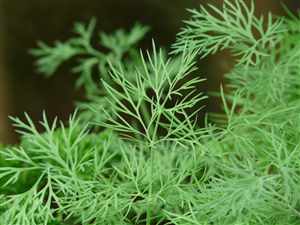Dill (Anethum graveolens)
Main Facts about Dill

Using Dill
Both Dill leaves and seads are used for flatulence and to increase mother's milk. Dill is said to be stimulating to the appetite and settling to the stomach and has been used to relieve babies with colic. To make an infusion, steep 2 tsp of seeds in 1 cup of water for 10-15 min. To make Dill water, add 8 drops of Dill oil to 1 pint of water. Chewing the seeds improves bad breath.Cooking with Dill
Dill leaves are used fresh in salads and garnishes. Dill seeds have a stronger flavor and are used whole or ground. Seeds also are used as a pickling spice.How to grow Dill
Dill grows in moderately rixh, well-drained, moist soil in full sun. For best results soil shouldn't be alowed to dry out. Shelter plants from strong winds. The plant is self-seeding. Whenever you plant it, chances are that new plants will grow there every year if you let the flowers go to seed. Seed are best sown directly in the ground just before the last spring frost date. Seedlings can be difficult to transplant.| Dates |
Dragon fruit
|